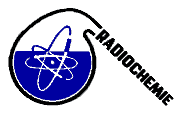Speaker
Mr
Marek Fikrle
(Nuclear Physics Institute ASCR)
Description
Several procedures of the preparation of the radionuclide 95mTc, a radiotracer useful for vari-ous purposes, were tested. A foil made of natural molybdenum was irradiated with protons or deuterons and after 5-6 weeks of decay the 95mTc radionuclide was separated. Three different separation procedures were tested. 1) Alkaline-oxidative fusion of the Mo target with sodium peroxide and sodium hydroxide followed by the dissolution of the melt in water and liquid-liquid extraction of Tc with methyl ethyl ketone. The organic phase with Tc was evaporated and the residue was dissolved in 2 M HNO3. 2) The target was dissolved in the mixture of hot concentrated HNO3 and H2O2. The solution was evaporated, the residue was dissolved in 0.1 M HCl and Tc was separated by extraction chromatography with a Tc selective chroma-tographic resin (PAN-Aliquat 336 with similar properties as Teva® Resin). 3) The molybde-num foil was dissolved in the mixture of concentrated H2SO4 and HNO3 (25:1) using micro-wave assisted digestion. To remove sulphate ions, which would interfere in the subsequent separation, barium chloride was added to the solution, the precipitate of barium sulphate was separated by filtration, and Tc was separated from the aqueous phase by extraction chroma-tography as given above. The column was washed with 1 ml of 0.1M HCl and Tc was stripped with 5 ml of 8 M HNO3. The overall separation yield was in the range of 70 to 95 %.
All the three methods can be used for Tc separation. However, the following difficulties have been encountered in the first two methods. In the first method, it is necessary to repeat the alkaline fusion step since the amount of reagents in one fusion is to be limited due to a very reactive nature of the flux used. Consequently, the liquid-liquid extraction step is to be re-peated several times. In the second method tested, a precipitate of undetermined composition appears during dissolution, which, unfortunately, contains about 25 % of 95mTc present in the target. The third method appeared superior over the other two methods tested, because it is fast, simple and provides a very good separation yield of technetium (> 90%).
Primary author
Mr
Marek Fikrle
(Nuclear Physics Institute ASCR)
Co-authors
Dr
Ferdinand Šebesta
(Czech Technical University in Prague, Faculty of Nuclear Sciences and Physical Engineering)
Dr
Jan Kučera
(Nuclear Physics Institute ASCR)

